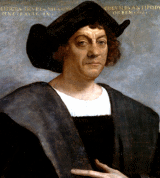
, in northwestern Italy. Under the auspices of the Catholic Monarchs
of Spain, he completed four voyages across the Atlantic Ocean that led to general European awareness of the American continents
in the Western Hemisphere
. Those voyages, and his efforts to establish permanent settlements in the island of Hispaniola
, initiated the process of Spanish colonization
, which foreshadowed the general European colonization
of the "New World
".
In the context of emerging western imperialism
and economic competition
between European kingdoms seeking wealth through the establishment of trade route
s and colonies, Columbus' far-fetched proposal to reach the East Indies
by sailing westward received the support of the Spanish crown, which saw in it a promise, however remote, of gaining the upper hand over rival powers in the contest for the lucrative spice trade
with Asia.
1492 Spain and Christopher Columbus sign the Capitulations of Santa Fe for his voyage to Asia to acquire spices.
1492 Spain gives Christopher Columbus his commission of exploration.
1492 Christopher Columbus sets sail from Palos de la Frontera, Spain.
1492 Christopher Columbus sails from La Gomera in the Canary Islands, his final port of call before crossing the Atlantic for the first time.
1492 Christopher Columbus's expedition makes landfall in the Caribbean, specifically in The Bahamas. The explorer believes he has reached South Asia
1492 Christopher Columbus becomes the first European to set foot on the island of Hispaniola, now Haiti and the Dominican Republic.
1493 Christopher Columbus leaves the New World, ending his first journey.
1493 Explorer Christopher Columbus arrives back in Lisbon, Portugal, aboard his ship Niña from his voyage to what is now The Bahamas and other islands in the Caribbean.
1493 Christopher Columbus returns to Spain after his first trip to the Americas.
1493 Christopher Columbus first sights the island of Dominica in the Caribbean Sea.
"Thanks be to God," says the Admiral; "the air is soft as in April in Seville, and it is a pleasure to be in it, so fragrant it is."![]()
Saw pardelas and a green rush near the vessel. The crew of the Pinta saw a cane and a log; they also picked up a stick which appeared to have been carved with an iron tool, a piece of cane, a plant which grows on land, and a board. The crew of the Nina saw other signs of land, and a stalk loaded with rose berries. These signs encouraged them, and they all grew cheerful.![]()
The Admiral says that he never beheld so fair a thing: trees all along the river, beautiful and green, and different from ours, with flowers and fruits each according to their kind, many birds and little birds which sing very sweetly.![]()
The two Christians met on the way many people who were going to their towns, women and men, with a firebrand in the hand, herbs to drink the smoke thereof, as they are accustomed.![]()
When there are such lands there should be profitable things without number.![]()

